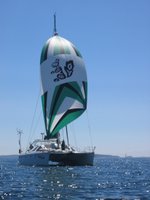We took a couple of days slowly day sailing making our way to Lamen Bay where the canoe races will be held.
This event had been started by a yachtie six years previously to encourage a local village day of participation. It has become an annual event and we were anxious to be there for it.
We arrived at midday the day before only to see several canoes paddling across to Epi Island—a considerable distance. We assumed they were practicing only to find that the races had started a day early—as we are learning “Island Time” is only a guideline and other factors are easily taken into account when the time comes so anything can be early, or more often late.
Apparently in this case a government minister had decided to get involved in sponsoring prizes (previously it had all been yachties) and he could only come the day before. The organisers were highly embarrassed as it had been advertised all over Port Vila and so they quickly decided to make it a 2 day event.
The evening had kava, a great string band and lots of dancing.
The next day we all went ashore and were able to participate in the canoe races. These are dugout outrigger canoes which are very awkward and we found uncontrollable. Even some of the local women had problems and we spent quite a lot of time going in circles and colliding with other canoes. Ken did well in his event where there were only fellow yachties and he easily won. He was then persuaded to go in the swimming race but age, sitting on a boat for too long combined with just having done the canoe race had taken it’s toll and although he managed to complete the course was slower then he would have liked.
The local men, having paddled out to the island the day before which would be equivalent to a marathon in our world opted to complete a shorter course.
The children had swimming races and the highlight was the tug-o-war. The children pulled against the white men, with their sheer numbers and low centre of gravity added to being dug into the sand eventually won.
They then challenged the local women who they easily defeated and then the white women. Finally they pulled against the local men and as they were struggling everyone ran to their side to lend a hand---by now there must have been a record number of bodies in a tug-o-war. Everyone collapsed on the beach in laughter it was so much fun.
Along with these events the local boys and men had a soccer tournament which due to the rough and bumpy terrain made for a game where the ball had to be kept in the air.
The girls had a volley ball tournament; girls do not play soccer here at all.
Along the beach the ladies had been selling paw paws and grapefruit and an enterprising young woman did a roaring trade selling ice cream.
Prize giving was at the end of the day where trophies were given to the winners of the major events. The yachtie who had originated the event gave prizes to many participants which he had solicited in NZ in the cyclone season.
The evening was a repeat of the last with the string band but included a buffet dinner which the local ladies had spent the day preparing.
The following day we walked to the baker who lived down the track and turn right at the intersection—we are getting used to directions which may include the big rock or the big tree, of which there are always many. True to form there were many intersections and eventually we were directed to the baker. He told us he had some bread from yesterday but if we wanted to wait 30 minutes he would have some fresh out of the oven. His oven was a stone kiln like structure where he builds a fire inside first to heat the rocks through and then pulls the ash and burnt wood out and puts in 84 loaves of bread in pans which come out looking lovely and browned on the top.
As it was too hot to put in a plastic bag for us he did what we are quickly learning is normal wrapping here, grabbed a banana leaf and wrapped in that.
After getting back to the boat we decided to see if we could find the dugong that lives in the bay. When we saw a tourist boat going out and dropping off snorkellers we quickly jumped in our dingy which we anchored and jumped in the water and found the 12 foot long dugong.
He is the original snuffleuffigus and he snuffles along the sea bed eating the sea grass. Remoras are attached to him and seem to cling as he moves. Every fifteen minutes or so he rises to the surface and takes a breath and descends again to resume his dinner. He took no notice of us so it was wonderful to just hang out with him for an hour or so. It was twenty feet deep but the water is crystal clear so it was easy to follow him along. It is related or perhaps the same as the manatee they have in Florida.
The following day it was time to move again, this time to do the two day passages we would need to get to Southwest Bay on Malekula Island to attend yet another Vanuatu festival which is next on our agenda.
Friday, September 03, 2010
Subscribe to:
Post Comments (Atom)

No comments:
Post a Comment